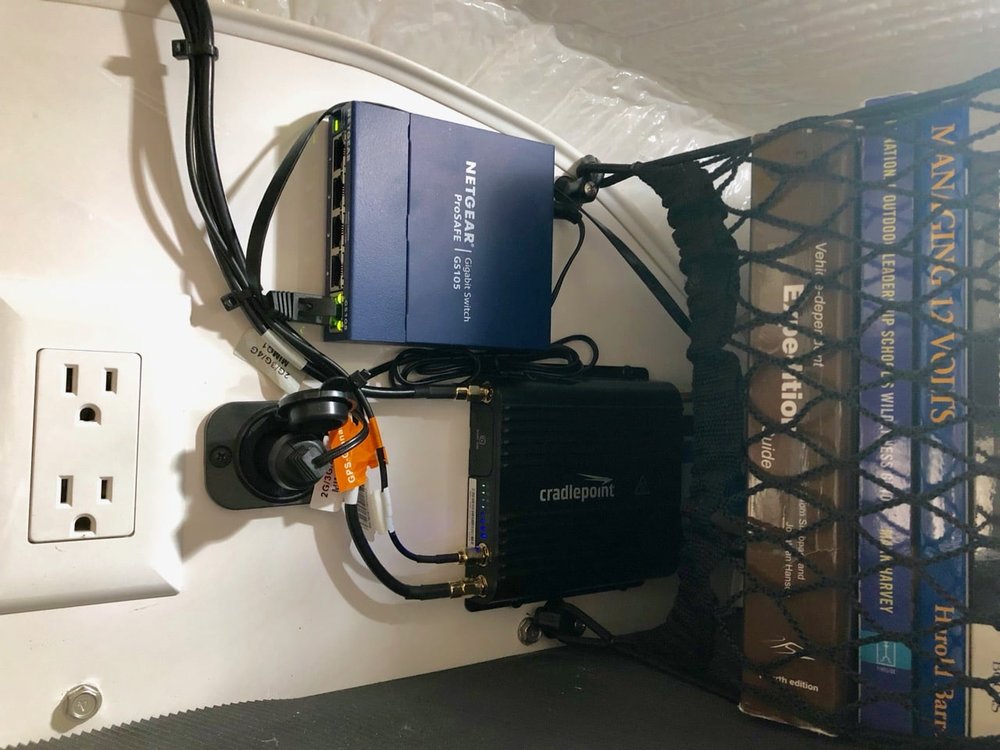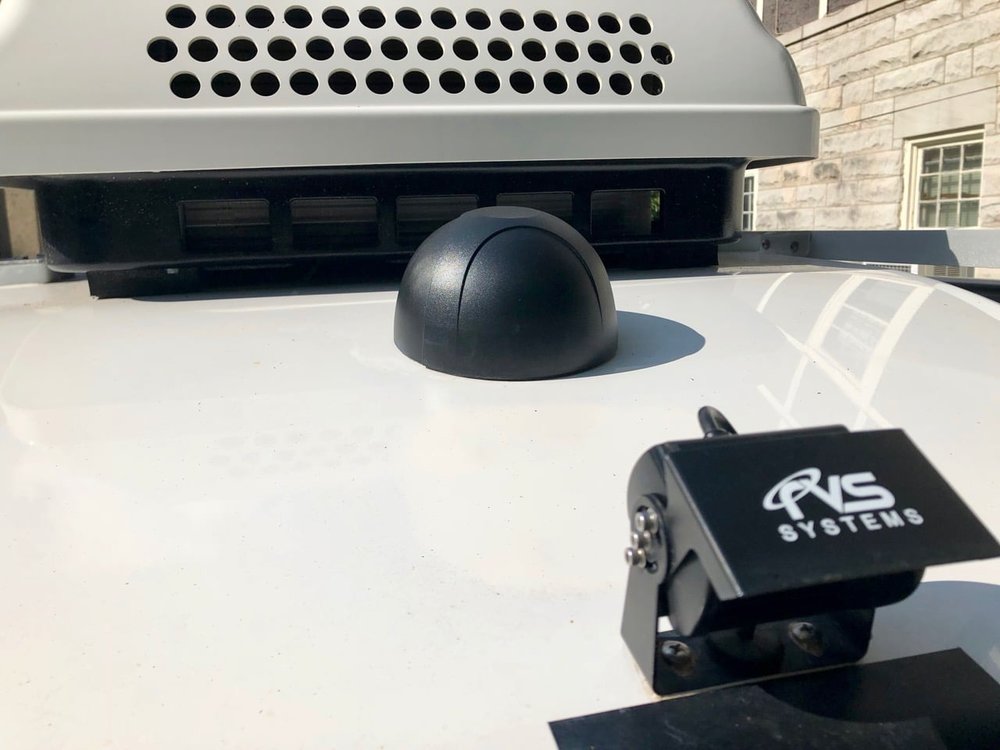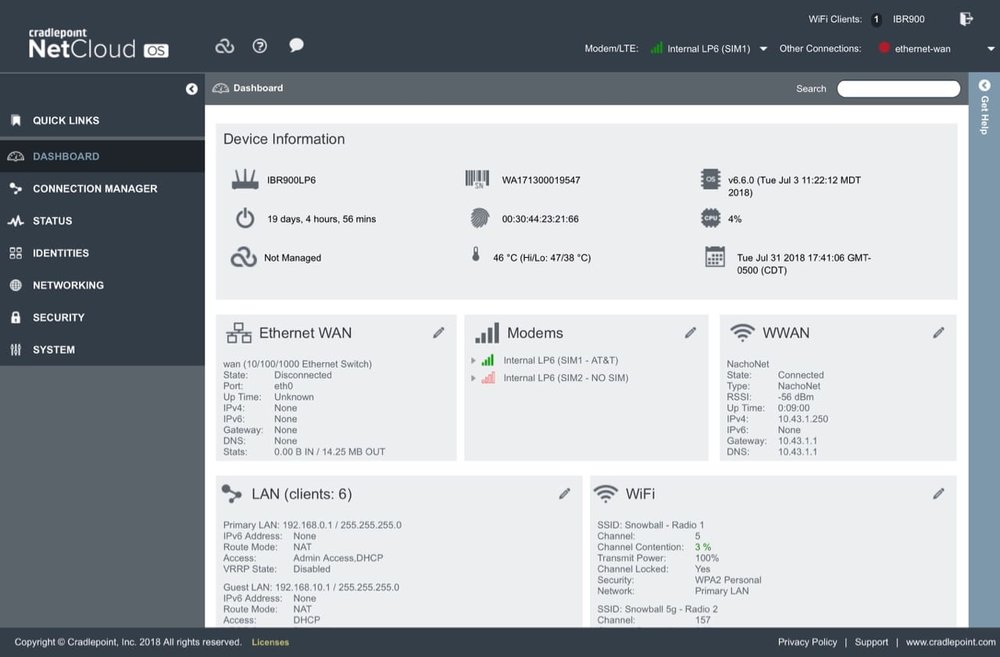-
Posts
3,835 -
Joined
-
Last visited
-
Days Won
212
Everything posted by Overland
-
I'm reviving this topic since I have another question relating to the heat strip model. On these units, there is an extra white wire running from the start capacitor to the heat strip unit. I assume when the start capacitor is removed that this wire gets attached directly to the C terminal of the run capacitor (since it's on the same terminal on the start cap as the other white wire that goes to the run cap C), but wanted to make sure and also post the issue in case anyone else runs across the same problem. Here's the wiring diagram for my unit:
-
Their website says that you can use diatomaceous earth to prevent insects - I assume it would get rid of them as well. I'd think it would be just as easy to dump the toilet and start over. We haven't had any bug issues with ours. I've been dumping and cleaning the toilet after each trip, which I'm sure helps in that respect. We've found that peat moss is much easier to deal with than the coco coir. We filled a bunch of zip locks with it and cary just enough to refill the toilet in case we need to. Our fuse was blown on delivery - either that, or it blew in the first few days. It's entirely possible that without a shower curtain, water from the shower could short out the fan and blow the fuse.
-

Fresh Water Tank Overflow Problem
Overland replied to roguebooks's topic in Mechanical & Technical Tips
Neat story, though I have no doubt that with care our trailer will last 20+ years. -
The dome is the antenna. It’s about 5” in diameter I guess. I noticed that they have a different version now on their website that’s a bit lower profile. The 4 small antennae that come with the router are maybe 4” or 5” tall. I’d have to find the box to be sure. The thing forward of the dome, or actually rearward, is our rear view camera. It’s a wired system from RVS. We really like it. We haven’t used the outside Wi-Fi feature yet, possibly because I just figured out it existed last week. I connected it to our Wi-Fi here at home just to see how it works. Like you I’m not sure how much we’ll use it on the road.
-
The model I have is the IBR900. I have their 5 in 1 antenna, which has 2 cell antennas, 2 wifi and a GPS antenna. The router itself comes with antennas, and in retrospect, I probably should have tried using them first before paying extra for an external antenna. And, even with an external antenna, it probably would have been wiser to get their 3 in 1, which just has 1 each of the cell and wifi antennas, and use the included antennas for the other two. In fact, I might try unhooking one of the external wifi antennas and use the included one instead, just because it probably makes more sense to have one inside the trailer. Not that we've had any connection problems. Here's where I've mounted the router and antenna: Mounting the antenna was scary since I had to drill through the roof, but actually very easy to do. I think it was a ½" hole through which you stick the cables and a threaded rod and then secure it from inside the attic. I think the bottom of the antenna had 3M tape also. Easy. I caulked it both at the hole and the perimeter, and I think it will be fine. Since I don't have a stereo, I used that circuit to power the router. In addition to wifi, it has two ethernet ports on the back, which came in handy for me as I could connect it directly to my Victron control panel for a full time internet connection. I added an ethernet switch to the other port just because I had one lying around so why not. I don't know what I'd use it for though. I'd say that the initial setup is actually pretty easy. Just insert your sim, plug it in and then connect to it via your phone or tablet. Then it asks you to change the wifi name and password and maybe a few other things and then you're good to go. Like a cable router that you might have at home, you can connect to the Cradlepoint in your browser by entering its IP address and it gives you an administrator page through which you can adjust any settings: What makes it less user friendly is doing things like connecting to an outside wifi for internet, which isn't intuitive in the least. So unintuitive, in fact, that I actually had no idea that it was even a feature until I ran across "WiFi as WAN" in the manual and wondered what on earth that meant.
-
Good point - I wasn't even thinking about the Diesels also being turbos, duh, so even more power to them. We should have a hill climb competition at the next rally, lol. I might be able to pull ahead at higher speeds, but then I'd have to stop for fuel halfway up.
-

Fresh Water Tank Overflow Problem
Overland replied to roguebooks's topic in Mechanical & Technical Tips
If I'm thinking about it right, this would be the way to test it: [attachment file=Screen Shot 2018-07-31 at 10.37.39 AM.png] 1. Shut Valve A. If that stops the water, then you've eliminated that valve, meaning that the problem is either the pump or Valve B. Also if it works, then you could temporarily leave that valve shut and stay on city water. If it doesn't stop the water, then obviously Valve A is bad. 2. If step 1 worked, then make sure that Valve B is shut and then unscrew the filter on the pump. Slowly reopen Valve A. If water starts to come out of the pump, then the problem is the pump. If not, then the problem will have to be Valve B. -
As mentioned, the problem with diesels today is that it's very difficult to outweigh the added initial cost and increased fuel price with fuel savings. If you're buying diesel, you're primarily doing it for a) range, and b) torque. When we were looking, I calculated the payback period for an F250 diesel over a Raptor to be 17.1 years, assuming 5,000 miles of towing per year and 8,000 daily driving. So for us, the range (510 miles +/-) vs the Raptor (325 miles +/-) was the primary advantage. As far as power and torque go, the advantage of diesels has been greatly reduced with the availability of turbo engines, particularly at altitude. We've been very pleased with the EcoBoost engine. Granted, we have the high output version, but the standard 3.5 isn't really that far behind. To throw a little math into the discussion, I was intrigued by John's post the other day about having to shift into low range in mountain passes, so out of curiosity I did some quick calculations of how much forward thrust was actually being provided at the wheels for a few trucks. In that case, he was talking about low speed acceleration coming out of switchbacks, at ~8,000 feet. I thought that was a really good example of real world towing power vs the advertised numbers that we usually use to compare vehicles - because in the end, it's the subjective experience in situations like that which really counts. So, in that example, assuming 8,000' altitude, pulling in 1st gear at around 2,500 rpm, and ignoring drivetrain losses: In the case of John's Land Cruiser, that's ~360 lb ft of torque @ 2500 rpm, less 3% per 1000' of altitude (86.4), times his first gear ratio of 4.79 and diff ratio of 3.31 (John said 3.8 but I think 3.31 is correct unless he's changed it). So (360-86.4)*4.79*3.31=4337.9 lb ft at the axles. Divide that by his tire radius of 1.375' (33" tires) gives a forward thrust of 3,154.84 lbs through 4 wheels. No surprise then that he'd want to shift into low range, which gave him an extra multiplier of 2.64, for 8,265.7 lbs thrust. Quite a difference and a nifty trick that he can do that. In contrast, a diesel F250, at I'm guessing 1,800 rpm or so, would give a massive 935 lb ft of torque at sea level, which translates to 711 lb ft. at 8,000 ft. So, 711*3.97(1st)*3.31(diff)/1.34(stock tires)=6,972.4 lbs thrust, or well over twice the Land Cruiser. So it's clear why people like diesels. But wait, my EcoBoost can maintain 510 lb ft of torque up to 10,000', and has a 4.10 read end, so we have 510*4.69*4.1/1.4 (34.5" tires) = 7,004.85 lbs thrust. EcoBoost for the win. At least at altitude. At sea level, those diesels can't be beat at the low end. BTW, that Honda Ridgeline that people keep asking about? (175-42)*3.36*4.25/1.23=1,544.1 lbs. Bless its little heart. My takeaway is that I don't think I'd ever buy a truck with naturally aspirated gas engine for towing. John's case with his LC is really unique I think, in that he does have the option to shift into low range on pavement. Otherwise, if you're the sort who absolutely has to have a V8 for whatever reason, just please be polite and use the pull outs. Addendum: another good reason to opt for a diesel is true engine braking. I haven't had any real issues and in tow mode my truck does a really good job of downshifting, but let's face it, it's not the same.
-
The freezer in our isotherm, which is smaller than the Dometic, will hold three of the slim ice trays from oxo - the ones that make cubes to fit water bottles. We’ve found that this is plenty for us for the day. That said, those ice makers do intrigue me. I think at least one other owner has one. I’d be interested to know how much power it takes and how long it takes to make ice.
-
I use Airstream dimensions when it comes to size limits - if it works for them then I have no problem doing the same. So our Ollie is always 18' when asked. And really even that's generous. In short campsites, we can park with the rear overhanging the grass so we probably only take up 16' or so. We stayed at Fishing Bridge. I wouldn't necessarily recommend it since it seems to be where all the big rigs go. But we really didn't mind since we were out at dawn and back in after dark. If you're going during the high season then I'd just recommend staying close to where you want to spend most of your time. Mid-May when we were there was busy but when we went back through in June traffic was a nightmare. I'd have gone insane if we were trying to see the park then. If you want to boondock, Slough Creek in Lamar valley seemed out of the way and in the midst of a ton of wildlife, including the Slough Creek wolf pack who have their den on the hillside across the creek. No reservations there though so it might be hard to get a spot.
-
Yep, this last trip we stayed in campgrounds much more often than normal, and we learned that the best neighbors were always fellow fiberglass owners. In Glacier, we had set up on a spot without neighbors, but returned later to find we were surrounded by Casitas. Probably the nicest group of people we've run across while camping. For some reason Escape owners seem to keep off to themselves, but Casita and Scamp people seem to be not just invariably outgoing, but also people whom you don't mind hanging around with. And yeah, those wheeled McMansions must be too nice to leave because you never see those people. At Yellowstone, where the campsites are basically parking spaces, we felt like we were camping in an aluminum slot canyon. At least they keep to themselves - just the mysterious glow from all the TVs inside. I do wish the parks would put a major limit on those things. Something in the neighborhood of 23'-6" is probably a good number.
-

Seboomook Wilderness CG on Moosehead Lake, Maine
Overland replied to Mainiac's topic in Campgrounds & Parks
Looks like a nice campsite, and not particularly crowded for this time of year. -
Both the inverter and shore power go through an automatic transfer switch, which will switch to shore power when available and default back to the inverter when shore power is cut. Shouldn't be a problem, though I don't have Oliver's setup so I don't know how much of a delay is involved and if it might be long enough for some electronics to turn themselves off - someone with direct knowledge may want to comment on that. But I'd think that a CPAP would be wired to come back on after a power interruption regardless.
-
Could be - I'll check. It was only a tiny amount, and only noticeable because it smelled of winterizing fluid. I should probably fill it and see if it leaks out. Regardless, I wouldn't trust those valves to keep fresh water safe. Maybe if you could take the tank out to really sanitize it, and then cap it off so that it was no longer connected at all to the grey tank.
-

Air Conditioner Noise - Dometic Penguin II owner's
Overland replied to Foy_Mirna's topic in Mechanical & Technical Tips
If you set the thermostat on Fan you can use the up/down arrows to cycle through hi/low/auto and it will apply to the AC as well. -
Thanks - that looks like a nice unit. You might pick up some heat from your solar panels in that location.
-
I think the answer to your last question is yes, but only one side of the blade unless you open the valve. You’d get grey water into the black tank but I guess that’s no big deal since you can either rinse it out, or just go through the process with clean water in the grey tank. I agree that mineral oil is probably no different than the Thetford stuff.
-
I’ll chime back in with a plug for the Cradlepoint router as an alternative to both the Wi-Fi ranger and the Wilson WeBoost. The cradlepoint is essentially a Wi-Fi ranger and Jetpack on steroids, giving you the possibility of having two cellular connections (two carriers), two Wi-Fi antennas, and two external cellular antennas, along with wired Ethernet. For us it’s been a great solution. We have a dedicated Wi-Fi network for the trailer with excellent signal inside and out (more than strong enough to use from the truck while traveling), provided by great 4g service thanks to the external antenna. So we have internet and Wi-Fi calling without the need for an external Wi-Fi or boosted cell signal, though it can use an external Wi-Fi for internet if you want. Right now we just have AT&T unlimited service but could add second sim from another provider and the router will switch automatically as needed. There’s also an expansion tray available that I believe will allow you to use two connections simultaneously for a faster connection. The system was recommended to me by another Oliver owner with knowledge of the field that far outstrips my own. I went with his advice on trust but we’re finding that it’s an extremely powerful device that becomes more and more useable the more we learn about its capabilities. I highly recommend it, with the caveat that it isn’t a consumer product and therefore isn’t as user friendly I imagine as other devices. That said, it worked fine for us out of the box with minimal setup. One of my summer projects (hopefully) is to make an antenna mast for a Wilson directional antenna that will plug directly into the second antenna connection on the cradlepoint. That way we’ll have our permanent antenna on the roof and a more powerful antenna that we can put out for long stays or emergencies.
-
Did you check the breaker on the campsite pedestal?
- 12 replies
-
Assuming you have the meter set on Ω, the reading should spike and then return to 1. The number that it jumps to doesn't matter. You can also test between the leads and the case to see if there's a short. The meter shouldn't move for that test. If you have a meter that will test capacitance then you can do the same test and compare the number to the range written on the side of the capacitor.
-

Will a cell phone booster work for you?
Overland replied to SeaDawg's topic in Mechanical & Technical Tips
We've found that our Cradlepoint system gets better reception than our phones. I'm sure that's partly due to the antenna being on the roof and partly due to it just being a better antenna in general. It doesn't do anything to help our phone reception of course, but often we'll have internet even when our phones can't find a tower. What I like, and wish we could justify taking advantage of, is that the router will accept two sims from different services. So if we wanted to pay for it, we could get an unlimited plan from Verizon to add to our AT&T plan and that would increase our coverage dramatically, especially out west. I've considered adding a WeBoost, since we could put the internal antenna right next to the router and get an even better signal. Maybe in the future. I've also considered just putting the Cradlepoint antenna on a mast to see what it would do. -
The F250 has hookups for a trailer camera, but not the F150. Unfortunately, it only lets you view it when in reverse so it's not useful as a rear view mirror when driving. There's an aftermarket modification that I could get for my F150 that would send the camera signal to the built in screen, but I haven't really looked at it to know how difficult it would be to install. I think the GM system is actually an aftermarket Echomaster product that they've licensed and the dealer will install, and I think you can get the same system for other makes.
-

How much electricity will your solar panels produce?
Overland replied to Overland's topic in Mechanical & Technical Tips
Yeah, I have in my little chart what we’d add with a portable panel. It’s surprising what a small panel can produce since it’s tilted. Especially in winter tilting the panels makes a huge difference. We do have 400Ah which equates to about 360 useable. With our extra solar, electricity is the one thing we never run out of. I wish I could do the same with water and propane. -
Couldn't say. Jason at Oliver could probably tell you. I know that my Truma water heater had to be either taken to one of their few service centers or be swapped out by Oliver, but I don't know how Dometic operates.








